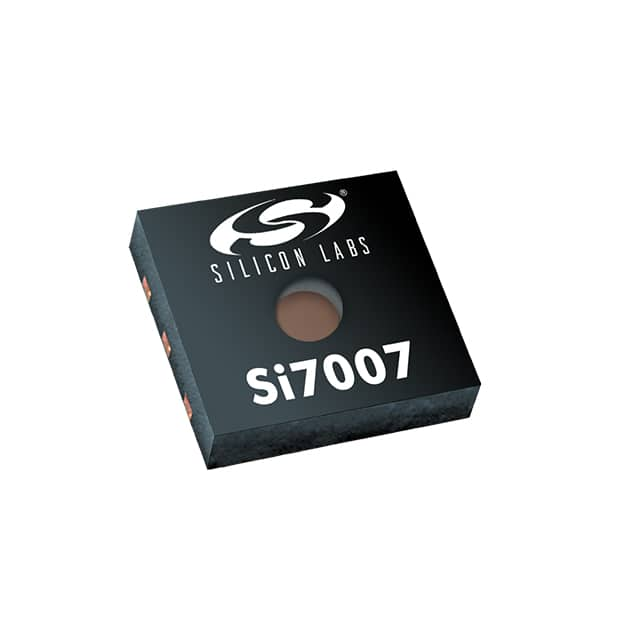Siehe Spezifikationen für Produktdetails.

SI7007-A20-IMR
Introduction
The SI7007-A20-IMR is a sensor product designed for use in various applications. This entry provides an overview of the product, including its category, use, characteristics, package, essence, packaging/quantity, specifications, detailed pin configuration, functional features, advantages and disadvantages, working principles, detailed application field plans, and alternative models.
Basic Information Overview
- Category: Sensor
- Use: The SI7007-A20-IMR is used for measuring temperature and relative humidity in various electronic devices and systems.
- Characteristics: This sensor offers high accuracy and low power consumption, making it suitable for battery-powered applications. It also features a digital interface for easy integration into different systems.
- Package: The SI7007-A20-IMR comes in a small form factor package suitable for surface mount assembly.
- Essence: The essence of this sensor lies in its ability to provide accurate and reliable temperature and humidity measurements in a compact and energy-efficient design.
- Packaging/Quantity: The sensor is typically supplied in tape and reel packaging, with specific quantities per reel depending on the manufacturer's specifications.
Specifications
- Temperature Measurement Range: -40°C to 125°C
- Humidity Measurement Range: 0% to 100% RH
- Accuracy: ±0.4°C for temperature, ±3% RH for humidity
- Supply Voltage: 1.9V to 3.6V
- Interface: I2C or SMBus
Detailed Pin Configuration
The SI7007-A20-IMR has a standard pin configuration as follows: 1. VDD (Power supply) 2. SDA (I2C data line) 3. SCL (I2C clock line) 4. GND (Ground)
Functional Features
- High Accuracy: The sensor provides precise temperature and humidity measurements, ensuring reliable data for various applications.
- Low Power Consumption: With its low power requirements, the SI7007-A20-IMR is suitable for battery-operated devices.
- Digital Interface: The I2C or SMBus interface simplifies integration with microcontrollers and other digital systems.
Advantages and Disadvantages
Advantages
- Accurate and reliable measurements
- Low power consumption
- Digital interface for easy integration
Disadvantages
- Limited operating voltage range
- May require additional calibration for specific applications
Working Principles
The SI7007-A20-IMR utilizes a combination of temperature and humidity sensors to measure the environmental conditions. The integrated analog-to-digital converter ensures accurate conversion of sensor readings into digital data, which can be accessed through the I2C or SMBus interface.
Detailed Application Field Plans
The SI7007-A20-IMR finds applications in various fields, including: - HVAC systems - Weather stations - Consumer electronics - Industrial automation - Medical devices
Detailed and Complete Alternative Models
Some alternative models to the SI7007-A20-IMR include: - SI7013-A20-IMR: Similar functionality with enhanced accuracy - HTU21D: Comparable temperature and humidity sensor with I2C interface - SHT30: Alternative sensor with wider supply voltage range
In conclusion, the SI7007-A20-IMR is a versatile sensor suitable for a wide range of applications, offering high accuracy, low power consumption, and a digital interface for seamless integration.
Word count: 466
Listen Sie 10 häufige Fragen und Antworten im Zusammenhang mit der Anwendung von SI7007-A20-IMR in technischen Lösungen auf
What is the SI7007-A20-IMR?
- The SI7007-A20-IMR is a digital humidity and temperature sensor designed for various technical solutions.
How accurate is the SI7007-A20-IMR in measuring humidity and temperature?
- The SI7007-A20-IMR has high accuracy with typical ±3% RH and ±0.4°C performance.
What is the operating voltage range of the SI7007-A20-IMR?
- The SI7007-A20-IMR operates within a voltage range of 1.9V to 3.6V.
Can the SI7007-A20-IMR be used in battery-powered applications?
- Yes, the low power consumption of the SI7007-A20-IMR makes it suitable for battery-powered applications.
Does the SI7007-A20-IMR have a digital interface for easy integration?
- Yes, the SI7007-A20-IMR features an I2C interface for seamless digital integration.
Is the SI7007-A20-IMR suitable for outdoor applications?
- The SI7007-A20-IMR is designed for indoor applications and may require additional protection for outdoor use.
What is the response time of the SI7007-A20-IMR in measuring humidity and temperature?
- The SI7007-A20-IMR has a fast response time, typically within 8 seconds for humidity and 5 seconds for temperature measurements.
Can the SI7007-A20-IMR be calibrated for specific applications?
- The SI7007-A20-IMR comes factory-calibrated, but user calibration can be performed if necessary.
What is the typical power consumption of the SI7007-A20-IMR?
- The SI7007-A20-IMR has low power consumption, typically operating at 1.9 µW during measurement.
Are there any special considerations for PCB layout when using the SI7007-A20-IMR?
- Proper PCB layout practices should be followed to minimize noise and ensure accurate readings from the SI7007-A20-IMR.

